
|
The Formation of a Rainbow |
Why Do We See Different Colors? |
Droplet Size |
Supernumerary Rainbows |
White Rainbows |
Interference Theory |
References |
|
A rainbow is just a distorted image of the sun. It results from raindrops which rearrange the sunlight via reflection and refraction.

The Formation of a Rainbow
Sir Isaac Newton found that white light is composed of all wavelengths of visible light.
White light is a mixture of all the colors of the spectrum, which are:
Red, Orange, Yellow, Green, Blue, Indigo, and Violet. If we break up white light
we can see the various components. A glass prism can be used to split
white light into various wavelengths.
This split occurs because each color in the white light has a different index
of refraction. Thus, the different colors will respond differently to the
glass. For example, blue light will refract more than the wavelengths corresponding to
yellow, and yellow light will refract more than the wavelengths corresponding
to red. This effect is called dispersion.
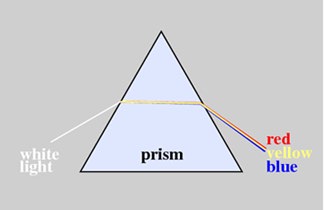
refractive bending of white light by a triangular glass prism
You can see a rainbow whenever you look opposite the sun at sunlit
raindrops (or water drops). The raindrop acts like a mirror in that it
reflects some of the refracted light back towards you, while other rays
leave directly from the opposite side. These refracted rays are the ones
that you see as a rainbow.
Thus, when the white light from the sun hits a raindrop the light
is dispersed as it enters (like in the prism). The
different colors undergo refraction and reflection due to the change
of index of refraction between the water and the air.
The formation of rainbows by raindrops was first clearly discussed by
Rene Descartes.
Let's assume that the rays from the sun are parallel and that all raindrops
are spherical. Of the many paths taken by the rays through a (spherical)
water droplet, several rays become concentrated near a minimum deviation angle.
These rays enhance the intensity
at that particular angle to produce the primary rainbow which we actually see.
The ray which is produced at the minimum deviation angle (the lowest
ray) is called the Descartes ray.
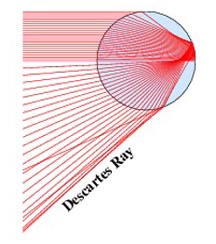
Why Do We See Different Colors?
As discussed earlier, the light from the sun is composed of white light
which is a mixture of all the colors of the spectrum. And like prisms,
the white light is also refracted and dispersed in a water droplet. Thus,
when white light hits the water droplet (assume spherical) the angles at which each color
emerges is different. Again, this is due to the fact that each color has
different indices of refraction, for example blue will refract more than
red. Red light emerges at about 42° and blue light emgerges at about
40.5° with respect to the incoming ray of light. If we recall the fact
that we only see the Descartes ray from a single drop we can conclude
that each water droplet contributes to only one color of the
rainbow.
Since each raindrop produces only one color, a rainbow must consist of
many raindrops. In fact, the raindrops lower in the sky contributes
to the blue light, and the drops higher in the sky contributes red light.
This is because we see red light at about 42° to our eye and blue light
at about 40.5° to our eye. Simple geometry then shows that the blue droplet
must be lower. So to see a rainbow of colors red, orange, yellow, green,
blue, and violet, the red light must be seen from a droplet higher than
the droplet for the other colors, and the violet light must be seen from
a droplet lower than the rest. Thus when we see a rainbow we see red on
the top of the arc and violet on the bottom respectively.
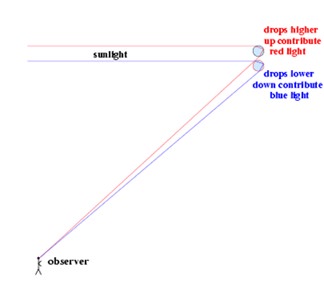
On occasions we see a secondary rainbow which is about twice as wide
as the primary rainbow, and has its colors reversed. Higher order rainbows
could also exist but I will not be covering the content of this material.
Droplet Size
The colors we see of the rainbow depends on the size of the raindrops.
If the drops are large, 1 millimeter or more in diameter, the rainbow
will be bright with well defined colors where red, green, and violet are bright
but having little blue. As the droplets get smaller, red weakens.
In fine mist, all colors except violet may disappear. Even smaller droplets,
less than 0.05mm in diameter (ie. fog droplets) produce rainbows
of overlapping colors that appears white. This is called the white
rainbow or fog bow.
So far we have assumed that all raindrops are spherical, and thus we
drew each drop's cross section as a circle.
But raindrops are a mixture of many sizes and shapes. A raindrop will
most likely not have a radius of more than a couple millimeters. This is because
they will usually break up due to the collisions with other raindrops.
But on occasions, in a rainstorm, when there are very few drops, drops
of a few millimeters in radius have been observed.
As a raindrop falls through the air, the droplet undergoes aerodynamic
distortion which causes the shape to distort, flattening the
drop. Small drops of radius less than 0.14mm remain spherical, but as
the size of the drop increases, the flattening becomes more obvious.
Spherical drops produce symmetrical rainbows. When the sun is near the
horizon, the rainbow is observed to be brighter at their sides, than
at the top. This is due to the fact that there is a complex mixture of
size and shape of the raindrops. The reflection and refraction of light
from a flattened water droplet is not symmetrical. For a flattened drop,
some of the rainbow ray is lost at the top and bottom of the drop. This
is why we see rays from these flattened drops only as we view them
horizontally. Thus, the rainbow produced by these large drops is bright
at its base. The fainter rainbow near
the top of the arc are produced only from small spherical drops.
| Diameter of water drop |
Features of the Rainbow |
| ~ 1-2mm |
The violet is very bright and the green is vivid. The rainbow
contains pure red, but barely any blue. There are many spurious
bows, violet-pink alternating with green without interruption
into the primary bow. |
| ~ 0.5mm |
The red is significantly weaker. There are fewer supernumerary
bows, violet-pink and green are again alternating. |
| ~ 0.2-0.3mm |
There is no more red. The bow is broad and well developed for the
rest of the colors. The supernumerary bows become more yellow.
If the diameter of the drops is around 0.2mm, a gap occurs between
the supernumerary bows. If the diameter is less than 0.2mm, a gap
is formed between the primary bow and the first supernumerary
bow. |
| ~ 0.08-0.1mm |
The bow is broader and paler, the only vivid color is violet. The
first supernumerary bow is well seperated from the primary bow
and visibly shows tints of white. |
| ~ 0.06 |
A distinct white stripe is contained in the primary bow. |
| < 0.05mm |
White Rainbows: Fogbows, Mistbows, Cloudbows |
Supernumerary Rainbows
Some rainbows have an additional faint arc or series of arcs just
inside the primary bow which are usually more obvious near the
top of the bow than at its base. These are called Supernumerary
Rainbows and were explained by Thomas Young in the early 1800's
as a result from interference due to the wave nature
of light.
See Interference Theory.
The spacing of a supernumerary bow depends on the size of the droplets.
Small drops yield a larger spacing than larger drops. If there are
a wide range of drop sizes, the supernumerary bow from each drop
will have different spacings which tend to overlap and cancel out the
clear variation of intensity that results from droplets all of the
same size.

a primary rainbow, a fainter secondary rainbow,
and several
supernumerary bows (pastel-shaded arcs) inside the
primary rainbow
White Rainbows
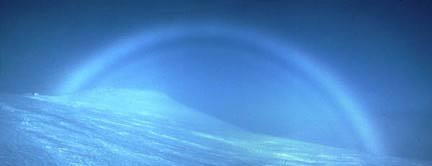
As water droplets get smaller, the colors of the rainbow begin to disappear.
In fine mist, all colors except violet may disappear. Even finer droplets
which are smaller than 0.05mm in diameter, for example fog droplets, produce the
white rainbow or fogbow.
Fogbows are formed similarly to rainbows in that light is reflected
inside a water droplet and emerges to form a bow opposite the sun.
Other than that, there are major differences. Rainbows are formed by
raindrops which are large enough so that the suns rays passing through
the drop follow a well defined 'geometrical optics' path. Much smaller
drops which form fogbows extensively diffract light to produce a broad
pale bow.
When light enters a fog droplet, the light is partially refracted and
reflected at each surface of the droplet. Most of the light entering a
droplet leaves directly from the opposite side without being reflected.
This process is similar to a rain droplet, but for a fog droplet the
light is spread by diffraction and no precise ray paths can be traced
within or near the droplet.
The color of a fogbow is pale because the fogbows formed in each color
are overlapped significantly.
click here for more information.
Along the main light path, inside the main arc of the fogbow, widely
spaced supernumerary bows are produced by constructive and destructive
interference of overlapping wave crests.
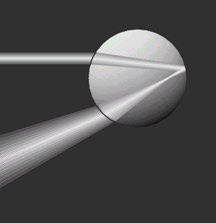
Direction of light in a fog droplet:
Light is refracted, reflected, and refracted again inside the droplet.
Here diffraction dominates, and there are no well defined ray paths.
Interference Theory
In 1803, Thomas Young claimed that the wave theory of light offered a much
superior explanation of the rainbow. Interference is the wave property
that we use to explain supernumerary bows. If two light waves having either coinciding wave crests or
troughs, the effect is constructive interference which produces a brighter color of light.
If two light waves have a coinciding wave crest and trough, the light becomes darker
than either wave's average brightness. This effect is called destructive
interference.Thus, when one portion of a light wave passes through another light
wave there may be either constructive or destructive intereference.
Supernumerary bows are caused by the interference of two different portions of
the same light wave.
The light waves from the sun is refracted into the droplet, and some of it is reflected
from the opposite side. Then, some of this reflected light is refracted out of
the drop to form a rainbow. This is similar as before when we used light rays.
But, as the wave front traverses through the drop, some waves folds over on itself.
When the two portions of the wave are superimposed, interference occurs which
produces a pattern of bright and dark bands. This interference pattern is drawn below.
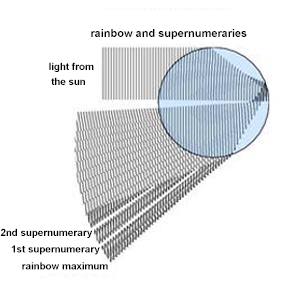
The bright and dark bands which radiate from the droplet creates the bright and
dark bands of light that form the rainbow. The region at the angle of
minimum deviation form the primary rainbow. This region is seperated from
the first supernumerary bow by a dark band and seperated from the second supernumerary
bow by two bands of darkness. Thus, the supernumerary bows are a part of the primary
bow.
We can now use interference to explain the pale or pastel colors of white rainbows. First,
recall that any bow is determined by refraction, with violet deviated the most and red
deviated the least. Thus in the primary rainbow, different colors occupy different
positions, with red on the outside. But the primary rainbow is just the first interference
maximum, and for each color the width of that maximum depends on the size of the
raindrops. For very large drops, the width of each color band will be narrow, therefore
the various colors do not overlap too much, which results in fairly pure rainbow colors.
On the other hand, for small drops each band of color can be so broad that all the colors
overlap. This combining of overlapping colors yields a pale or white bow.
References
Greenler, Robert, Rainbows, Halos, and Glories Peanut Butter Publishing 1999
Laven, Philip, Optics of a water drop
Lee, Raymond L., and Fraser, Alistair B., The Rainbow Bridge Penn State Press 2001
Lynch, David K., and Livingston, William, Color and Light in Nature Cambridge University Press 1995
Lynds, Beverly T., About Rainbows
Minnaert, Marcel G. J., Light and Color in the Outdoors Springer-Verlag 1974
Nave, R., Rainbow Concepts
Walker, Jearl, Light from the Sky Scientific American
Atmospheric Optics
Rainbow Reading
Craig Ryomoto
April 28 2003
Mathematics 309
all diagrams are drawn in Postscript
click on diagrams to view PS source
click on photographs for link to related website

